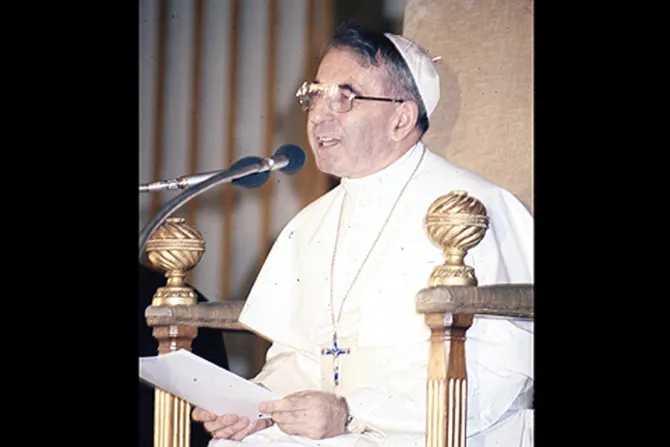Vatican City, Oct 20, 2015 / 07:03 am
On his path to beatification, John Paul I can count on a very special supporter: Pope emeritus Benedict XVI.
Years ago, he was among those who witnessed the compilation of John Paul I's 'positio,' the dossier of documents and testimonies that will determine the virtues of a candidate for sainthood.
That dossier has now been completed, Bishop Giuseppe Andrich of the Diocese of Belluno-Feltre announced Aug. 26. The bishop heads the native diocese of John Paul I.
Cardinal Albino Luciani was elected Bishop of Rome Aug. 26, 1978, taking the name John Paul I. He died unexpectedly on Sep. 28, hardly a month later.
John Paul I is still remembered each Aug. 26 in Canale d'Agordo, the small town in northeastern Italy where he was born. There, a Mass is celebrated to commemorate the anniversary of his election to the papacy.
When Bishop Andrich announced the progress of John Paul I's cause at the last commemorative Mass, he said the 'positio' included a testimony by Benedict XVI.
Then-Cardinal Joseph Ratzinger was among the witnesses for John Paul I's cause of beatification when the diocesan procedure began in 2003.
There are two steps for a cause of beatification before it is examined in Rome. A diocese or religious institute gathers testimony about the life and virtues of the Servant of God. The candidate's public and private writings must be collected and examined.
This documentary phase of the process can take many years, as it did in the case of John Paul I. In the meantime, Cardinal Ratzinger had been elected Bishop of Rome, as Benedict XVI.
As a Pope, he was directly involved in the final decision for an eventual canonization. Therefore, he could no longer be included in the list of witnesses for John Paul I.
The diocesan phase of the investigation ended in 2006. The Congregation for the Cause of Saints examined of the volumes of documentation and authorized the beginning of the so-called 'Roman phase.'
In this step, the congregation commits the case to an official called a relator, who oversees the cause through the rest of the process and ensures the dossier is properly prepared.
Even this process can take years.
In the same period that John Paul I's cause advanced, Benedict XVI resigned, Feb. 14, 2013. He could once again be a witness in the cause of his predecessor.
Stefania Falasca, a journalist and vice postulator of John Paul I's cause of canonization, said that after Benedict XVI's resignation the postulator again asked for his testimony in the case.
The postulator of John Paul I's beatification cause is Bishop Enrico dal Covolo, rector of the Pontifical Lateran University.
Benedict XVI sent his testimony in written form. It is considered an "extra procedural" testimony, as it came when the diocesan phase had already concluded.
After the positio is submitted, theologian consultants to the Congregation for the Causes of Saints, together with the congregation's Promoter of Faith, will vote on whether to approve the document for further consideration.
If they approve, the members of the congregation then will give a decision. If they too approve, the cause for beatification will be referred to Pope Francis for approval.
A miracle has already been attributed to the intercession of John Paul I: the 1992 healing of Giuseppe Denora, from the Diocese of Altamura-Gravina-Acquaviva delle Fonti. Denora was suddenly healed from a malignant stomach tumor after he sought the late Pope's intercession.
St. John Paul II declared his immediate predecessor a Servant of God on Nov. 23, 2003. If John Paul I's cause advances, he will be given the title "Venerable."



